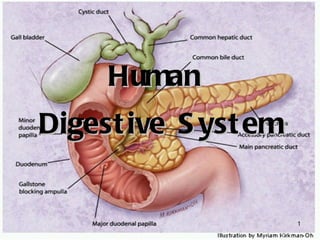
Human digestion teacher
- 1. Human Digestive System
- 9. Swallowing
- 10. What Happens During Breathing and Swallowing? trachea (windpipe) glottis During breathing, the larynx is lowered and the glottis is open. pharynx oesophagus larynx (voice-box) air Normally, air passes into the trachea ( windpipe ) while food passes into the oesophagus .
- 11. What Happens During Breathing and Swallowing? During swallowing, the larynx is raised and the glottis is covered by the epiglottis . This prevents food particles from entering the trachea. pharynx trachea (windpipe) oesophagus glottis epiglottis food particles larynx (voice-box)
- 12. What Happens During Breathing and Swallowing? Occasionally, small particles of food or water may get into the larynx or trachea. trachea (windpipe) larynx (voice-box) food particles
- 13. What Happens During Breathing and Swallowing? This automatically induces violent coughing to force the food particles or water out and to prevent choking. trachea (windpipe) larynx (voice-box) food particles
- 16. Wall here constricts. Circular muslces contract; longitudinal muscles relax Wall here dilates Direction of movement of food Circular muscles relax Longitudinal muscles contract
- 19. HCl converts inactive pepsinogen and prorennin to their active forms
- 33. Lacteal – fatty acids and glycerol recombine in the epithelium to form fat which then enters the lacteal as fine fat droplets Blood capillaries – transport sugars and amino acids away from the small intestine One cell thick epithelium – for efficient absorption of food particles This continual transport of digested food substances maintains the concentration gradient for the absorption of digested food substances.
- 35. What happens to amino acids and glucose after absorption? Products released from liver into general blood circulation Molecules pass into the epithelial cells Through walls of capillaries in the villus and into bloodstream The capillaries join up to form veins Veins unite to form 1 large vein: Hepatic Portal Vein Hepatic portal vein carries blood to liver Liver stores or alters products of digestion
- 38. What happens to fatty acids and glycerol after absorption? Molecules pass into the epithelial cells Recombine into fats again in the epithelial cells Fats enter the lacteals Lymph (fluid in lacteals) + fat = chyle Lymphatic vessels discharge chyle into bloodstream
- 40. Villi – absorption by diffusion Diffusion From intestine To To liver
Notas del editor
- (1)The initial stages of eating and swallowing are under voluntary control. (2)Once food enters the mouth the teeth break it down into smaller and smaller pieces. This has the dual function of making the food easier to swallow and increasing the surface area of food on which the saliva can act. The tongue, lips and cheeks assist the teeth in the process by allowing the food to be "rolled" around the oral cavity. The mechanical action described above produces a softened bolus of food which is now ready to be swallowed. The correct biological term for swallowing is deglutition. (3) shows the voluntary stage of deglutition. Here the bolus is pushed into the upper part of the pharynx (known as the oropharynx ) by the action of the tongue. The pharyngeal stage of deglutiton is stimulated when the bolus enters the oropharynx. This stage of swallowing is mainly due to a reflex response. Various nerve receptors send messages to the deglutition centre of the brain stem. (see medulla and pons in your notes on the central nervous system). (4)This sets off muscular contractions in the pharynx. The soft palate closes off the nasopharynx. The vocal cords in the larynx are moved up and towards the front of the throat thus closing it off to the passage of food. This is extremely important in preventing food from entering the airway.I am sure we have all experienced the unpleasant feeling of food or drink going the "wrong way"!! Another effect of the process is to widen the opening of the oesophagus thus making the passage of the bolus along the alimentary canal easier. (5) As the bolus pushes it's way into the oesophagus it automatically pushes the epiglottis downwards further closing off the airway. (6) The bolus then enters the oesophagus and the final stage of swallowing begins. This final stage is known as the oesophageal stage of deglutiton. http://greenfield.fortunecity.com/rattler/46/upali4.htm
- Figure 6.4 page 92
- Figure 6.4 page 92
- Figure 6.4 page 92
- Figure 6.4 page 92
- Figure 6.6 page 93
- Compare the stomach wall n oesophagus wall? Which is thinker? Why? ( pro
